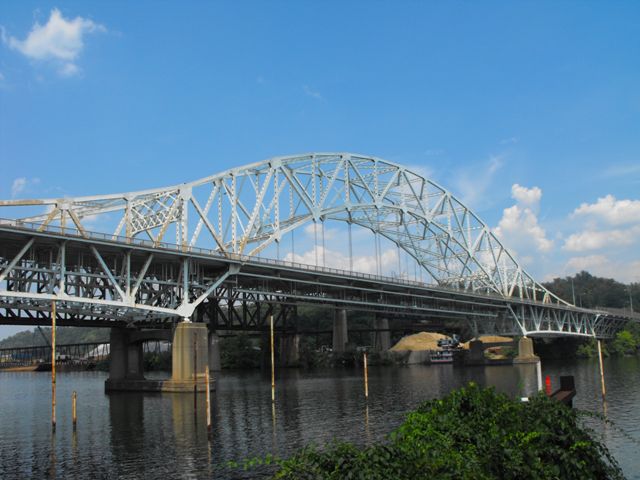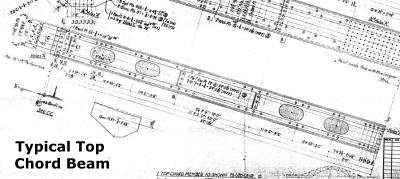We Recommend:
Bach Steel - Experts at historic truss bridge restoration.
BridgeHunter.com Phase 1 is released to the public! - Visit Now
Belle Vernon Bridge
Speers - Belle Vernon Bridge

Primary Photographer(s): Nathan Holth
Bridge Documented: August 1, 2010
Speers and Belle Vernon: Fayette County, Pennsylvania and Washington County, Pennsylvania and Westmoreland County, Pennsylvania: United States
Metal Continuous (Arch and Suspended Deck) 12 Panel Rivet-Connected Warren Through Truss, Fixed and Approach Spans: Metal Continuous 8 Panel Rivet-Connected Warren Deck Truss, Fixed
1951 By Builder/Contractor: Fort Pitt Bridge Works of Pittsburgh, Pennsylvania
1993
450.0 Feet (137.2 Meters)
2,066.0 Feet (629.7 Meters)
75 Feet (22.86 Meters)
3 Main Span(s) and 9 Approach Span(s)
62007004001415

View Information About HSR Ratings
Bridge Documentation
View Archived National Bridge Inventory Report - Has Additional Details and Evaluation
This bridge was originally known as simply the Belle Vernon Bridge, but today is also often called the Speers-Belle Vernon Bridge.

This bridge is a rare example of a suspended deck continuous through truss bridge. The bridge design is noted for looking like a trussed through arch, however because the truss spans that flank the pretend arch span in the center are connected to it such that they form a continuous structure, the bridge does not function as an arch, but rather functions as a continuous through truss bridge with an arched shape. The deck is then connected to the arch-shaped truss via vertical suspenders. Genuine arch bridges are by definition of a simple structure and cannot be continuous. As mentioned, the three main spans are continuous. To the west of the main spans are three continuous deck truss spans, but these three spans are not continuous with the main spans. These three approach spans consist of a central eight panel 212 foot Warren deck truss flanked by 6 panel 159 foot spans. To the east of the main spans is a single simple six panel 153 foot Warren deck truss span. At the western end of the bridge is a single girder span, while the east end of the bridge has four girder spans.
The bridge's trusses are traditionally composed for the period. Rivets and built-up beams were still in wide use at this time, but v-lacing and lattice had been replaced by the more massive yet less visually attractive solid box beams with punched holes (sometimes called hand holes). The Belle Vernon Bridge displays this design trend for the mid-20th Century.
The main spans of the bridge retain good integrity aside from the replacement of deck and railing. The approach spans have been altered by the addition of cantilevered beams that serve to widen the deck of the bridge. This alteration speaks to the pre-interstate history of this bridge. The bridge's approaches ended up being widened in 1993 to increase the length of acceleration and deceleration lanes that were needed for exits at the ends of the bridge. More information on this history available here. Despite these alterations, the bridge is noteworthy for a major engineering project and for its unusual design, one of only three in Pennsylvania. Further, since PennDOT has elected to demolish nearly every pre-1950 historic highway bridge on the Monongahela River between Pittsburgh and West Virginia, this bridge is rapidly becoming one of the most important bridges on that section of this great river, which was once rich with historic bridges. Indeed, the future of the Belle Vernon Bridge itself is uncertain, as a massive widening project has been slowly progressing on I-70. The deck width of the Belle Vernon Bridge is narrower than the dimensions of this widened I-70, and so it is quite likely that this bridge will face demolition and replacement in the years to come.
Several sources, including HistoricBridges.org for a time, described this bridge as a cantilever truss. However it does not appear to have hinges that are needed for a cantilever function. As such, the bridge appears to function as a continuous truss. Furthermore, the original plans for the bridge describe the main spans as a "continuous truss."
Information and Findings From Pennsylvania's Historic Bridge InventoryDiscussion of Bridge The main span of the 2,066'-long bridge is a 450'-long cantilevered thru truss span with a suspended deck. It is continuous with 238' long deck truss approach spans. The other approach spans are built up deck girders and both simple and continuous deck girders. The main span is supported on a pair of stone piers with reinforced concrete stems in the river and the approach spans are on concrete column bents and concrete abutments. Approach spans 2,3,4, and 8 have been were widened in 1992-1993 by the addition of "sloped" trusses extending outward from the bottom chords. The original railings were replaced with modern safety shape barriers at the same time. The bridge is technologically significant for its design with a suspended deck. It ranks as one of the major post-war efforts of the Department based on its size and complexity of design. Discussion of Surrounding Area The Belle Vernon Bridge carries I 70, a four-lane, barrier divided, interstate highway with shoulders, over two state highways (SR 88 and SR 906) , two railroads (Conrail and the Pittsburgh & Lake Erie Railroad), and the Monongahela River in a sparsely settled area with a mix of mid- to late-20th century residential and commercial development. I 70 is an interstate route that is composed of sections of existing roads that were taken over into the interstate system. The bridge was originally built to carry LR 268. Bridge Considered Historic By Survey: Yes |
![]()
Photo Galleries and Videos: Belle Vernon Bridge
Bridge Photo-Documentation
Original / Full Size PhotosA collection of overview and detail photos. This gallery offers photos in the highest available resolution and file size in a touch-friendly popup viewer.
Alternatively, Browse Without Using Viewer
![]()
Bridge Photo-Documentation
Mobile Optimized PhotosA collection of overview and detail photos. This gallery features data-friendly, fast-loading photos in a touch-friendly popup viewer.
Alternatively, Browse Without Using Viewer
![]()
Maps and Links: Belle Vernon Bridge
Coordinates (Latitude, Longitude):
Search For Additional Bridge Listings:
Bridgehunter.com: View listed bridges within 0.5 miles (0.8 kilometers) of this bridge.
Bridgehunter.com: View listed bridges within 10 miles (16 kilometers) of this bridge.
Additional Maps:
Google Streetview (If Available)
GeoHack (Additional Links and Coordinates)
Apple Maps (Via DuckDuckGo Search)
Apple Maps (Apple devices only)
Android: Open Location In Your Map or GPS App
Flickr Gallery (Find Nearby Photos)
Wikimedia Commons (Find Nearby Photos)
Directions Via Sygic For Android
Directions Via Sygic For iOS and Android Dolphin Browser
USGS National Map (United States Only)
Historical USGS Topo Maps (United States Only)
Historic Aerials (United States Only)
CalTopo Maps (United States Only)


